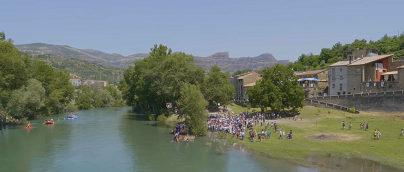
If you prefer to always view the website in English, please click here.
If you prefer to always view the website in English, please click here.
The largest lake in Spain was a coal mine until only 10 years ago. During the As Pontes mine exploitation period, in Endesa we took charge that the natural space occupied by the mine had a sustainable future. Now, everything around the old working mine is populated again by indigenous fauna and water sports can be practised in a huge lake that has even a beach area.
At Endesa, we are committed to conserving the environment and we apply this to each of our businesses. The mines that we ran between 1972 and 2015 in Andorra (Teruel), As Pontes (A Coruña), Peñarroya (Córdoba) and Puertollano (Ciudad Real) are no exception.
353 million tonnes of coal were produced over 44 years. We were the top national coal producers in the late 80s with an annual production of 15 million tonnes, representing 42% of the national production. Since 2016, all the mining centres have been involved in a orderly closing process with environment restoration works.
The renovation of land around the former mines was a priority in the planning and development of our mining projects. The aim was always to end up improving the initial condition of the natural areas around the sites.
“Since the time of the genesis of its mining projects, the criteria of recovery of lands affected by mining activity prevailed in Endesa, with the ultimate goal of achieving, once the benefit of the site was obtained, the return of the lands to their early use.”
Manuel Jiménez Hernando. Mine planning and management.
The most emblematic restoration project is in As Pontes, where the former mine has become the largest lake of Spain: 865 hectares and 547 cubic hectometres of water, now used for water sports with swimming and recreational areas. The external mine waste tip, where sterile material from the site accumulated, is today a natural spot with a biologically-rich vegetal cover, that has been colonised by native fauna in a natural process. In the most recent studies performed, 217 plant species and 205 species of vertebrate animals have been identified.
In the other mining centres, restoration has recovered 2,360 hectares for agriculture or for developing indigenous vegetation and fauna, despite being semi-arid, difficult to repopulate areas .
To be noted is the case of Puertollano, where 560 hectares have returned to a cattle-farming use after the restoration, with a productivity higher than in the unmodified surrounding lands. Currently it has a plantation of 28,000 olive trees with a mean annual production of 250,000 kg of olives from which excellent oil is obtained.
The unique nature of these projects has turned our mining area restoration experience into a national and international benchmark.
“The challenge is that restoration is sustainable and the entire ecosystem grows by itself in the future.”
Antonio Hermosilla Medina. Mining Administration and Management.
To ensure a sustainable restoration, the exploitation method used was back filling. A method which allows to carry out simultaneously the exploitation and restoration work. Therefore, we need not to wait until the end of the mining project to start undertaking the restoration work of the entire surface affected.
During this process, both the external and the internal mine waste tip have been given the shape of waves similar to those of the relief in the environment. Subsequently, they are covered with topsoil and then they are fertilised and sown with native plants. The final stage of the restoration project of a mining project is the recovery of the final pit, generally through storing water.
The success of a sustainable restoration is to achieve a balance between the water mass, the development of the riverside plants and colonisation of the native fauna. We have been able to reach that balance in As Pontes, Peñarroya, Andorra and Puertollano, four natural spaces recovered which are a benchmark in sustainable development.
As highlighted by Antonio Hermosilla, who from the Endesa Mining Administration and Management Area has directly experienced this evolution, it is very gratifying to see that we have contributed to creating something. “Where you heard the echo of co-workers and machines, now you hear the sound of birds, fauna and amphibians”.





